Distinguished Critique: "Batman: Year Two" Review
This sequel to "Year One" fails to sufficiently explore interesting ideas which deserve deeper reflection than they receive
—by Nathan on December 18, 2023—
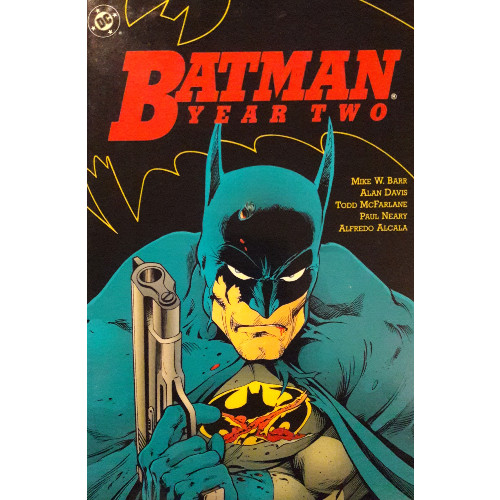
"Batman: Year One" is a standout narrative, a four-part update on the Dark Knight Detective by Frank Miller, reintroducing readers to the vigilante in a post-Crisis on Infinite Earths world. We get into the mind and intentions of the Caped Crusader as he makes his first appearance in Gotham City as a billowing shadow, forms an alliance with not-as-yet-Commissioner James Gordon, and strikes at the heart of corruption poisoning the city streets. No killer clowns, waddling men in business suits, or former district attorneys with split personalities. The only "rogue" introduced is an infamous cat burglar.
Shortly thereafter, folks at DC decided to tell a story about Batman's second year of crime fighting in Detective Comics, originally slated to run concurrently with Miller's narrative. Those plans were changed, but when the story was set to be created, writer Mike W. Barr came in, retooling the narrative to better fit the post-Miller reconstruction of Batman.
If you're even the tiniest bit familiar with the resulting "Year Two," chances are it's because you've seen an image of Batman holding a gun, drawn by Alan Davis. Yes, a gun. And not just any gun, as we'll determine later. The image intends to shock and disturb, cause comic fans to look at it sideways, eyes slanted, as they try to reconcile a gun-wielding Batman with his historical "No killing" policy. So what writer in their right mind would give Bruce Wayne a gun? And why would they think he'd use it?
“Batman: Year Two”
Writer: Mike W. Barr
Pencilers: Alan Davis, Todd McFarlane
Inkers: Paul Neary, Alfredo Alcala, Todd McFarlane
Colorists: Adrienne Roy
Letterers: Richard Starkings, Augustun Mas, John Costanza, Todd Klein
Issues: Detective Comics #575-578
Issue Publication Dates: June-September 1987
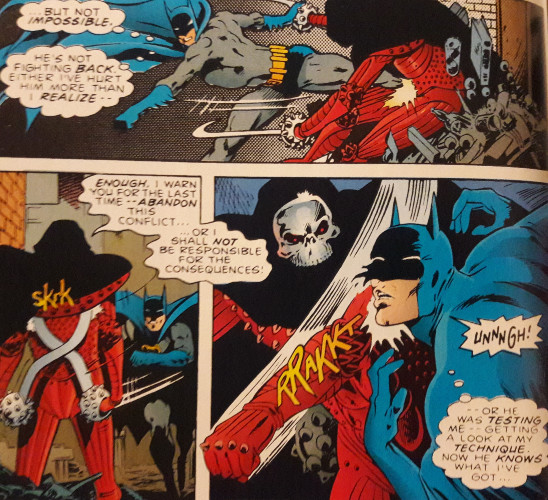
The "Batman uses a gun" controversy comes up often in other reviews I've looked at for this story, and for good reason–amazingly, it's central to the whole kit and caboodle. The gun is the standout image which lingers in the back of your brain once you finish the narrative, making you wonder if you genuinely just saw what you think you just saw. It's why some reviewers downright despise "Year Two" and a reason why some readers actually enjoy it. I've seen division between fans and dissenters of this story, as some reviewers decry its "jump the shark" moments take it too far away from the grounded, gritty Batman established by Frank Miller while others commend it for embracing wacky aesthetics in a genre becoming needlessly grim and violent as the 80s closed out. "Yeah, even Batman's using a gun now, nerds," the issues seem to taunt.
But that mindset diminishes what Barr is attempting to accomplish here, which is, surprisingly, an incredibly ambitious bit of literature. I haven't read much of Barr's bibliography, but here, he's chomping at the bit to throw whatever ideas he possesses at the Bat Cave wall and hope they stay put.
They don't. None of them do. But we can at least commend Barr for trying.
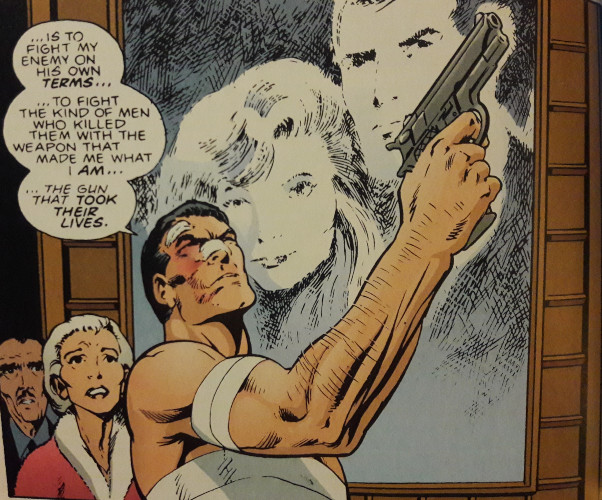
The whole narrative bears this "What if-?" quality which, were "Year Two" intentionally confined to a parallel dimension separate from mainstream DC continuity, would largely work. Questions such as "What if Batman kept the gun his parents were murdered with?" or "What if Batman wasn't the first vigilante stalking the streets of Gotham?" or "What if Batman was forced to team up with his parents' murderer?" have narrative heft to them, feeling rich with symbolism. They appear worthy of some exploration. But not in a then-canonical Batman narrative and, more importantly, not all at the same time.
There's some merit to each of these ideas. Controversial as the "Batman uses a gun" concept may be, knowing Bruce kept the weapon that murdered his parents (setting aside, obviously, logical questions such as: "How did he get the gun? Did he hide it from the cops as a kid? Did he steal it later from evidence? Why would Bruce Wayne steal a gun?") does provide decent symbology. "Year Two" isn’t the only narrative to toy with this idea–Andy Diggle had Bruce handle the weapon as a reminder of his loss in Batman Confidential, and the Robert Pattinson-led The Batman incorporated the gun into his suit. Both draw clear inferences from the gun's symbolic weight, which Barr tries very awkwardly.
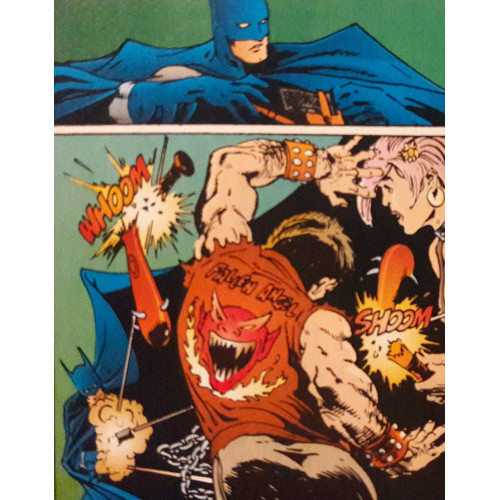
Something about Bruce deciding "I’m gonna use the gun that killed my parents to shoot criminals" in "Year Two" feels, not so much a slap in the face of his prevailing "No guns" philosophy (keep in mind, this is Bruce's second year of crime fighting, so I think we can chalk that up to his continually developing vigilante morality), but like a jolt of shock over substance. It's a cool idea, but in execution, Barr seems to just want to toss it in the story to surprise readers. He kinda muses about Bruce descending into the same lethal tactics utilized by the criminals he seeks to stop, but ultimately, there's not enough of a throughline to make the idea feel unpacked thoroughly. The gun is never essential, and so whatever struggle Bruce does endure over whether he's willing to go down this path feels inconsequential. If Barr wants Batman to shoot a gun, Batman will shoot a gun. We're not given any singular moment of transformation because of the gun–Bruce doesn't accidentally murder a criminal, for example, and allow that to change his stance on using weaponry.
We can point to Barr's other ideas hampering any development on the gun front. Barr introduces vigilante the Reaper as Batman's predecessor, a criminal-killer from the past who's returned to reclaim his mantle from this upstart hotshot who doesn't have the spine to end these scummy lowlifes for good. Popping up here and there and shouting his catchphrase ("Fear–the Reaper!") at every opportunity, the grim ghoul is a neatly designed antagonist who ultimately lacks heft. Barr has the opportunity to weave an engaging mystery surrounding his identity, and as obvious as the culprit may have been if he went this route, Barr reveals the man behind the mask first chance he gets. Barr later creates parallels between Batman and the Reaper's origins, adding a tiny twist but kicking subtlety to the curb. There's no mystery and no opportunity to discover depth.
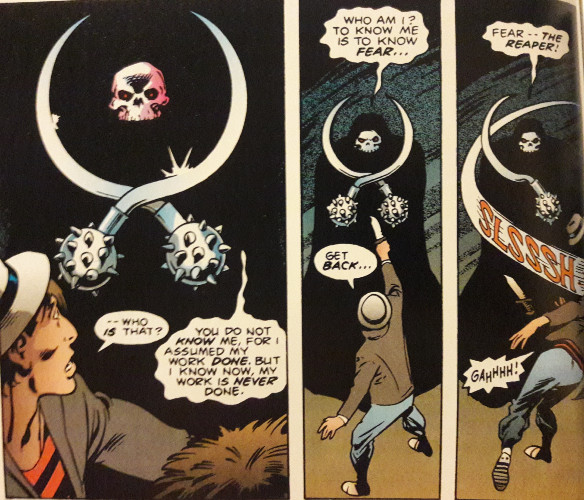
We understand his conceit early on. The Reaper is Batman's opposite, and he's not the only vigilante or villain in comic book history to mirror Batman's own origin or intentions. Where the Reaper lacks engagement is Barr’s inability to provide the subtlety or symbolism; it takes very little brainpower to identify the similarities and differences between Batman and the Reaper–their origins are basically indistinguishable, one clearly kills while the other generally abhors murder (even if he isn't so adamant on that fact here), and they both utilize horror imagery (bats, skulls) to convey fear. Heck, the Reaper just tells people to be afraid of him before striking them down with his scythes. At least Batman conforms to his traditional "skulking through the shadows ominously" before bringing the beatdown on criminals. You get the sense that the Reaper is a disappointed parent, chiding Bruce for his unwillingness to kill the rotten apples in Gotham's basket.
Which seems like the right time to bring in Joe Chill.
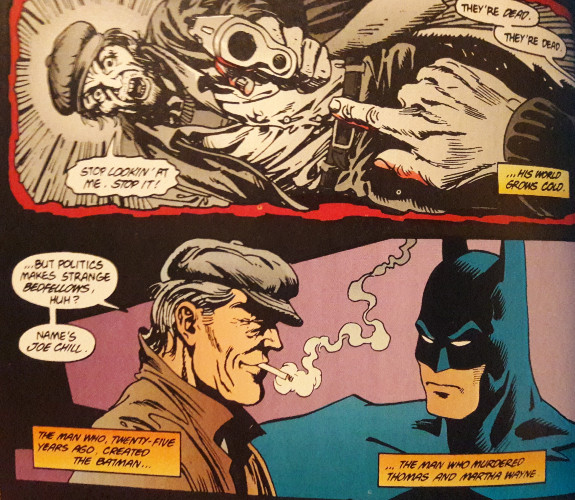
We'll ignore, for now, the sheer coincidence that, in a city teeming with thugs and crooks, Batman just so happens to be partnered with the guy who plugged his parents two decades earlier. We'll even ignore, for now, Batman thinking he has no other shot at the Reaper other than, well, shooting at the Reaper and teaming with the very criminals he plans to eventually incarcerate. Let's go back to the "ideas" idea: on paper, bringing in the man who murdered the Waynes in this capacity is shocking, surprising and, in the narrative itself, ends an issue on a cliffhanger. "Oh, snap," you’re supposed to think, "Batman’s gonna be buddies with the guy who killed his parents? He's partnering with the man who essentially created Batman all those years ago in Crime Alley?" Yes, he is.
Again, Barr attempts to thread this duality for Bruce–as much as he loathes the criminal element, just like he loathes guns, he has no other option but to seek their services. And, if you want, you can also chalk this development up to Batman's relative newness to the costumed crimefighting lifestyle. But, c'mon, let's be fair: he has other options. After losing a rather nasty fight to the Reaper, Batman grabs a gun and seeks help from the criminal element. He basically tells Gordon he's going to betray him shortly before this, like he's made up his mind and there's no turning back. Is there some arrogance we're supposed to see here? Some unhealthy obsession with getting revenge on the Reaper for beating the tar out of him earlier? There's really no good reason explored for this bizarre shift in Bruce's thinking other than "This could be cool." Thematically, it could work. I think it's generally difficult for a writer to find a strong reason to force their hero to team up with their arch-nemesis–how dark do things really need to get for Spidey to pair up with the Green Goblin or for Daredevil to temporarily ally himself with the Kingpin? But if you can do it well, without your hero abandoning their morals or at least offering them a decent philosophical struggle, the idea can work. Spidey teaming with Venom to take down Carnage works because Spidey intends on stopping Venom, too. Batman's not backed into some corner the way Barr wants us to believe. He has no decent reason to side with Chill.
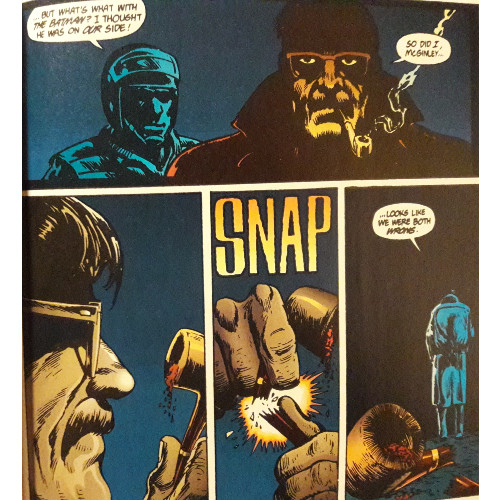
On top of the inconsistent characterization and strange coincidental plot developments, "Year Two" casually throws in a whole mess of smaller concepts meant to propel minor bits of story forward. Bruce develops a relationship with a young woman (who wants to become a nun for some reason but sets that aside to pursue Bruce?), and you know from the start how this is going to end. Leslie Thompson appears throughout the piece, her and Alfred essentially interchanging roles as they each tell Bruce he's being dumb. Gordon stews in discontentment over feeling betrayed by Batman, never questioning or confronting his ally and just bitterly grousing. Little subplots fly hither and yon, never really coalescing. Everything, from the larger plot points to the smaller developments, is given little room to adequately breathe and feel essential to the overarching story.
Artistically, we get improvement. Alan Davis provides a stellar opening chapter, penciling a brutal battle between Batman and his new foe. An early sequence displays Batman taking out a cluster of crooks in the dark, a scene which feels most comparable to the tone Miller established in "Year One." Davis ditches, however, before everything goes off the rails, being replaced by a then-up-and-comer named Todd McFarlane. Shades of McFarlane's later work on Amazing Spider-Man, Incredible Hulk, Spider-Man, and Spawn are certainly noticeable, particularly in the final issue, which he inks as well as pencils. Inker Alfredo Alcala does McFarlane few favors in the middle chapters; though allowing vivid detail, the second and third issues don't help McFarlane's work feel distinguished, save for a handful of panels, and it's really only the final issue where his style feels more pronounced.
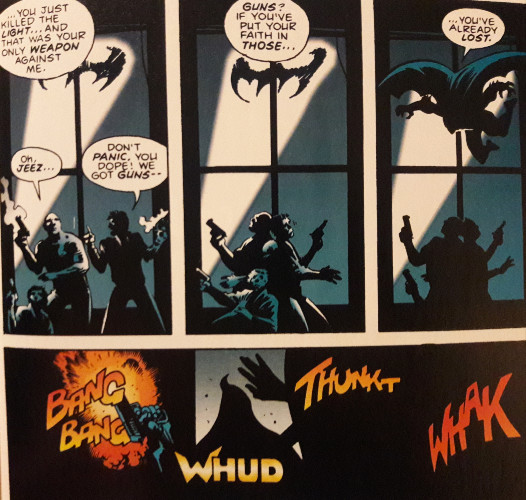
Honestly, I would have preferred Davis' consistent style for the whole narrative. I appreciate McFarlane enough as an artist, but Davis comes out of the gate with nicely defined characters and detailed backgrounds. It’s nothing groundbreaking, just clearly a good Alan Davis comic. But McFarlane, either hampered by his relative lack of experience or the inker he's partnered with for most of the narrative, takes precious time to develop a style. I really want to blame the inker because the fourth chapter is a noticeable improvement over the second and third issues. And though it's perhaps an unfair assessment given my understanding of McFarlane's later work, his pencils give that finale an edginess typical of the 90s a few years prior to the decade’s beginning. Under Davis, the Reaper is visually cool. Under McFarlane, the Reaper begins embodying all the pitiful grit of the 90s, which McFarlane and protege Rob Liefeld were in part responsible for.
I don't quite know what Barr's original pitch for his story was before it was hacked apart to make "Year Two." I don't know what he abandoned or what he kept. All I'm aware of is what I can see and read: a mess of ideas which should have been explored individually and offered the weight they deserved to carry. I don't care if Batman uses a gun if you give him a good reason for it or offer him a genuine struggle for his decision. I don't care if another vigilante battled bad guys before Batman if you give him a genuinely good reason to appear. I don't care if Batman bumps into the guy who murdered his parents if you're willing to adequately explore the tension between them. Barr tries. There's effort employed. But given the story's length and the sheer amount of concepts Barr keeps throwing into the blender, it's no wonder “Year Two” isn’t the critically acclaimed masterpiece its predecessor became.